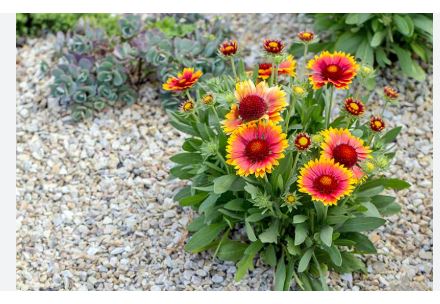
Gaillardia aristata, commonly known as the Blanket Flower, is part of the Gaillardia genus within the Asteraceae family, which also includes daisies and sunflowers. This species is characterized by its vibrant, daisy-like flowers with a central disk surrounded by ray florets, often in combinations of yellow and red. The species name “aristata” refers to the bristly nature of the plant’s leaves and stems.
Blanket Flower is native to North America, specifically found across the western United States and into parts of Canada. Its range includes areas from British Columbia in Canada, south through the Rocky Mountains and Great Plains states like Montana, Wyoming, Colorado, Utah, Idaho, and into New Mexico, with some extensions eastward into the Dakotas and Nebraska. This species thrives in dry, open environments such as prairies, meadows, and along roadsides, reflecting its adaptation to well-drained soils and full sun.
Historically, Gaillardia aristata has been valued by indigenous peoples for its ornamental beauty and potentially for medicinal uses, though specific uses are less documented compared to other native plants. The name “Blanket Flower” is thought to derive from the colorful patterns of traditional Native American blankets or perhaps from its ability to blanket areas where it grows. Over time, it has become a popular garden plant for its long blooming period, vibrant colors, and hardiness. The hybridization of Gaillardia aristata with Gaillardia pulchella has led to the development of many garden varieties, expanding its use in ornamental horticulture.
Blanket Flower is well-adapted to USDA Hardiness Zones 3 through 10. This broad range reflects its capability to endure both the cold winters of northern climates and the hot, dry summers of the southwestern U.S. Within these zones, Gaillardia aristata benefits from full sun exposure, well-drained soils, and can often tolerate periods of drought, making it an excellent choice for xeriscaping, rock gardens, or any landscape where low-maintenance, drought-tolerant plants are desired. Its resilience and adaptability have made it a favorite among gardeners looking for both aesthetic appeal and ease of care.
Identifying Characteristics
- The flowers are large, daisy-like, with a central disk that’s often dark red or purplish, surrounded by bright, ray-like petals that can be yellow, orange, or red, often with bi-colored patterns.
- Known for its long blooming period, it typically flowers from early summer into fall, providing color for several months. Deadheading can extend this period even further.
- Plants generally grow to heights of 18 to 30 inches, with a spread that can match or slightly exceed the height, creating a bushy appearance.
- Leaves are lance-shaped to oval, with a rough, hairy texture, which aids in reducing water loss. They are arranged alternately along the stem, with basal leaves forming a rosette.
- It has an upright, clumping growth habit, forming dense mounds that can be ideal for borders or as a mass planting in gardens.
- Features a fibrous root system that helps in anchoring the plant in its often dry, native habitats, contributing to its drought resistance.
- Attracts a variety of pollinators including bees, butterflies, and hummingbirds, enhancing garden biodiversity.
- Very hardy, withstanding cold winters and hot, dry summers, making it suitable for a wide range of USDA zones.
- Adapts well to poor, sandy, or rocky soils, preferring well-drained conditions. It’s quite drought-tolerant once established but can also thrive in average garden soils.
- Can be propagated by seeds, which are often self-sown in garden settings, or by division. While not overly aggressive, it can spread through its seed production, offering a naturalizing effect in the landscape.
Cultivation
Site Selection
Choose a location with full sun exposure for best flowering. Blanket Flower thrives in at least 6 hours of direct sunlight daily and can tolerate heat well.
Soil Preparation
Prefers well-drained, sandy, or loamy soil. Amend heavy clay soils with sand or compost to improve drainage. It’s adaptable to poor soil conditions but will benefit from good soil structure.
Planting
Plant in spring after the last frost or in early fall. Space plants about 12 to 18 inches apart to allow for air circulation and growth. Plant at the same depth they were in their pots.
Watering
Water regularly until established, especially in the first growing season. Once established, it’s drought-tolerant but will produce more blooms with occasional watering during prolonged dry periods.
Mulching
Apply a thin layer of mulch to help retain soil moisture and keep weeds at bay, but don’t over-mulch, as this can retain too much moisture around the plant’s base.
Fertilization
Does not require heavy feeding. If soil is particularly poor, apply a light layer of balanced, slow-release fertilizer in early spring. Over-fertilization can lead to leggy growth and fewer flowers.
Pruning and Deadheading
Deadhead spent flowers to encourage continuous blooming. Cutting back by about one-third after the first flush of blooms can promote a second wave of flowering.
Pest and Disease Management
Generally resistant to pests, but watch for aphids or spider mites, which can be controlled with water sprays or insecticidal soap. Good air circulation helps prevent fungal diseases like powdery mildew.
Propagation
Seeds can be sown directly into the garden in spring or fall. For more control, start seeds indoors 6-8 weeks before the last frost. Division can be done in spring or fall every few years to rejuvenate plants.
Winter Care
In colder zones, a light mulch around the base can protect the roots from extreme cold, although Gaillardia aristata is quite hardy. In warmer zones, no special winter care is typically needed.